A boy who cried “wolf” several times when there was no wolf isn’t believed when he witnesses a real murder.
It’s possible, one can conjecture, that The Window might not have ever been released. Made it was. Howard Hughes had produced it in 1947, reluctantly because he preferred movies about he-men (The Conqueror, 1956) and buxom women (Underwater, 1955), and this film was about a marginalized little boy.
Besides reviving the career of its ten-year-old hero, Bobby Driscoll, The Window was the sleeper hit of 1949 and remains one of the lesser known great film noirs of the 1940s. On loan from Walt Disney, Driscoll had previously made The Song of the South (1948), still seldom seen today because of its view of post-Civil War slavery. In 1950, he would make the version of Treasure Island, his Jim Hawkins opposite the deliciously hammy Robert Newton as Long John Silver.
There is an added poignancy when a child is in danger as Driscoll is here, but with or without him, The Window boasts all the prerequisites of a well made film noir. The cinematographer-turned-director, Ted Tetzlaff—the last film he shot was Alfred Hitchcock’s Notorious (1945)—probably gave the credited cinematographer, William Steiner, a few suggestions.
There’s no reluctance, however, in giving Steiner his due. His shots of the adults are often from a low angle to replicate the boy’s viewpoint. The shadows are deep and dark. The interiors of the New York Lower East Side tenements (where the film was shot on location) of both Driscoll’s parents and that of the husband-and-wife murderers are cramped, dingy and dismally alike.
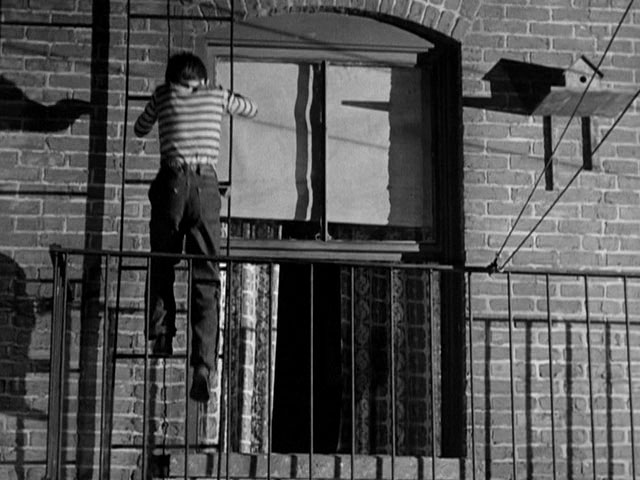
The editing of Frederic Knudtson (The Defiant Ones, 1958, Inherit the Wind, 1960) is brilliant, especially in the scary climax when Driscoll runs afoul of the murderers. Film noirs work best with motifs and here the motif is windows; in the opening credits, the camera moves in on a window, à la Hitchcock’s The Lady Vanishes (1934), Shadow of a Doubt (1943), Psycho (1960) and Rear Window (1954) where the camera moves through a window, from inside to the outside. And it’s from a window that Driscoll witnesses the murder.
The film is based on a novel by Cornell Woolrich. Like another noir writer, Dashiell Hammett, Woolrich was an alcoholic, but also a mother-dominated recluse who had few friends. Countless films are based on his dark-hued novels and short stories, including The Black Angel (1946), The Night Has a Thousand Eyes (1948), Rear Window (1954) and The Bride Wore Black (1968).
After a day playing with the neighborhood boys in the ruins of a deserted building, that night young Tommy Woodry (Driscoll) takes his pillow and leaves his hot bedroom to sleep on the cooler fire escape landing of the floor above. Through the few inches between the bottom of the pull shade and sill of the window he can see the struggling feet of two men and a woman. A pair of bloody scissors falls to the carpet, then the body of one of the men.
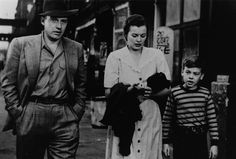 When he rushes to awaken his mother (Barbara Hale, eight years from the beginning of her twenty years as Perry Mason’s secretary on the Raymond Burr TV detective series) with another of his fantastic tales, she tells him to go to bed, that it was just a nightmare. “You’re soaking wet,” she says. (The film was made in the dead of winter and the actors were given hot soup and wrapped in blankets to keep warm.)
When he rushes to awaken his mother (Barbara Hale, eight years from the beginning of her twenty years as Perry Mason’s secretary on the Raymond Burr TV detective series) with another of his fantastic tales, she tells him to go to bed, that it was just a nightmare. “You’re soaking wet,” she says. (The film was made in the dead of winter and the actors were given hot soup and wrapped in blankets to keep warm.)
Nor will his father (Arthur Kennedy), who has an unspecified night job, believe that Mr. and Mrs. Kellerson (Paul Stewart and Ruth Roman) in the apartment above are murderers. Both parents are rather overly adamant in their refusal to even consider their son might, this time, be telling the truth.
When continual insistence doesn’t change their minds, Tommy goes to the police station. He’s not believed there either, but, just in case, an officer sends a detective (Anthony Ross) to the Kellerson apartment under the guise of a building inspector. He checks out each of the three rooms. The only possible incrimination is a stain on the carpet near a window. Mr. Kellerson explains it’s from a leak and as there is a corresponding stain in the ceiling, the detective disregards it.
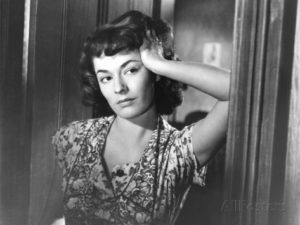 Then Mrs. Kellerson brings to the boy’s mother a misdelivered telegram. Mrs. Woodry’s sister in a distant town is ill. Tommy believes it’s a trick, as he’s aware the woman knows his mother has a sick sister. With a suggestion from the boy, Mr. Woodry convinces his wife to call. The sister did send the telegram.
Then Mrs. Kellerson brings to the boy’s mother a misdelivered telegram. Mrs. Woodry’s sister in a distant town is ill. Tommy believes it’s a trick, as he’s aware the woman knows his mother has a sick sister. With a suggestion from the boy, Mr. Woodry convinces his wife to call. The sister did send the telegram.
So mistrusting is the mother of her son’s story that she does a dumb thing, insisting Tommy confront Mrs. Kellerson with his story and apologize. The steely look of feigned innocence is Roman’s acting highlight. The Kellersons are thus alerted—there’s no doubt at any point that they did commit the crime.
While the mother leaves town that night, the father must go to work. Knowing Tommy plans to run away, Mr. Woodry nails shut the fire escape window in the boy’s room (a safety violation) and locks the front door, leaving the key in the lock. (Now who would leave an outside door key in the lock?!)
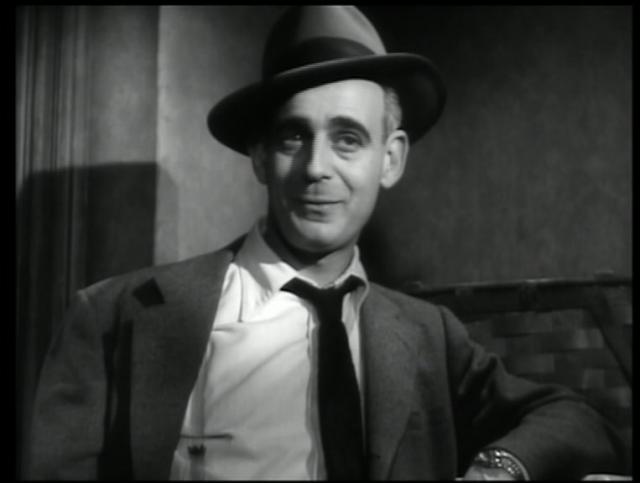 Undeterred in his plan, Tommy pushes the key through the lock with a coat hanger. Mr. Kellerson, hovering in the hall, accommodates Tommy by placing the key in the loop of the hanger as the boy fumbles to drag the key under the door. When Tommy opens the door——
Undeterred in his plan, Tommy pushes the key through the lock with a coat hanger. Mr. Kellerson, hovering in the hall, accommodates Tommy by placing the key in the loop of the hanger as the boy fumbles to drag the key under the door. When Tommy opens the door——
Mr. Kellerson talks friendly to the boy, buttering him up, saying he’s totally innocent and suggesting the three of them, with his wife, walk to the police station and settle things.
On the way, Mr. Kellerson pulls Tommy into a dark alley. The boy escapes and a chase ensues through an abandoned tenement building. In the process, Tommy discovers the body of the murdered man. Mr. Kellerson eventually falls to his death some three stories when part of a beam gives way under him.
Tommy is stranded on the other end of the beam. Firemen arrive and he has to jump, safely, into a life net.
Mrs. Kellerson is rounded up and Tommy and his parents ride in the back of a police car on the way to the station. The boy pledges never to tell any more lies and his father says he’ll believe him from now on.
The actors do justice to both themselves and to the film. Bobby Driscoll, immediately likable with his bright smile and expressive eyes, is clearly the center of the film and carries it effortlessly, quite a feat for a child of ten. Arthur Kennedy, one of the most undervalued of actors, nominated unsuccessfully for five Oscars over a ten-year period, is credible as the controlled but loving father.
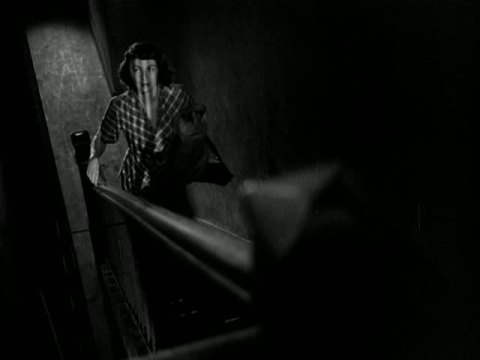 While Barbara Hale comes across well as a sympathetic mother, it’s Ruth Roman, best remembered as Farley Granger’s girlfriend in Hitchcock’s Strangers on a Train (1951), who makes the greater impression, though she has fewer screen opportunities than Hale.
While Barbara Hale comes across well as a sympathetic mother, it’s Ruth Roman, best remembered as Farley Granger’s girlfriend in Hitchcock’s Strangers on a Train (1951), who makes the greater impression, though she has fewer screen opportunities than Hale.
Paul Stewart, a veteran of Orson Welles’ radio Mercury Theatre, made his transition to movies with Citizen Kane (1941) and quickly established himself in sinister roles (Johnny Eager, 1941, Kiss Me Deadly, 1955), with occasional stints as benign doctors (Twelve O’Clock High, 1950) or friend of the hero (Mr. Lucky, 1943).
The Window is only seventy-three minutes. It was nominated for Best Film Editing. The score by Roy Webb is appropriately dramatic and highly noirish, a strength of his style—Murder, My Sweet (1944), The Spiral Staircase (1946), Out of the Past (1947). Bobby Driscoll received an Oscar for Best Juvenile Actor of 1949, not an annual recognition, only awarded when deserved.
[embedyt] https://www.youtube.com/watch?v=ntoZsumz1gg [/embedyt]
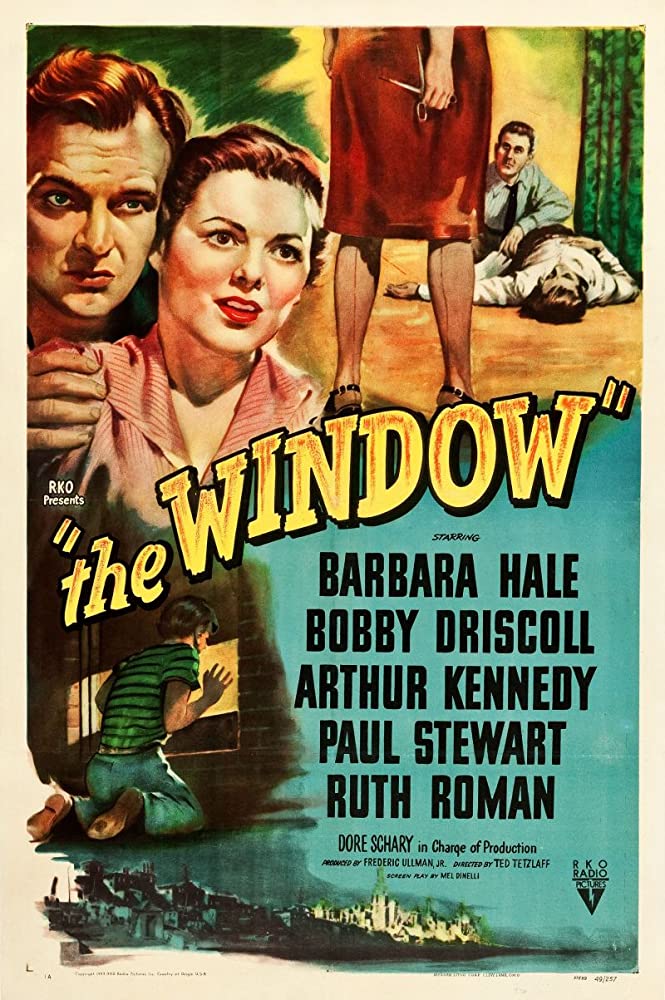
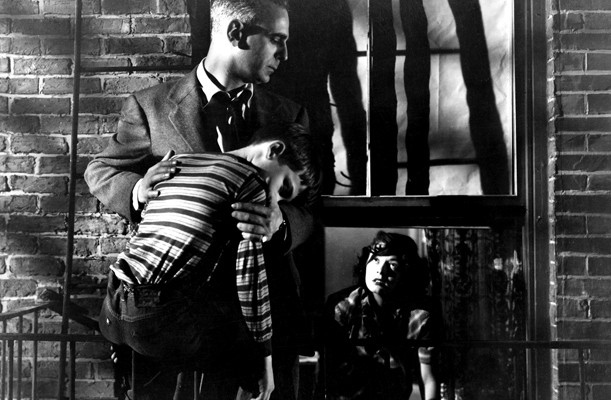
Thank you for coming back! I love your reviews and comments.